Khrushchev dumped all the blame for the Kharkov catastrophe on Stalin
The first morning of May 12, 1942 after an hour of artillery and aviation preparation for the offensive went Soviet troops. In the northern sector, 11 rifle divisions were thrown into battle in the first echelon with the support of 7 tank brigades and 20 artillery regiments of the RGK. Literally immediately it became clear that a significant number of enemy firing points could not be suppressed, in addition, there were much more of them than expected. The German defenses were stronger than they thought. This was the first surprise for our troops. The Soviet troops were met with dense enemy fire, and they literally had to gnaw through the German defenses, suffering heavy losses.
However, by the end of the day, the flank 21 and 38 armies broke through the main lane and advanced 6 – 10 km. The 28-I Ryabyshev army, which was the main striking force on this sector, was less successful; it managed to penetrate the enemy defense only 2 km, although the army had 59,5 guns and mortars and 12 tanks on 1 km. The commander of the 38 Army, K. S. Moskalenko, inspired by the success of his troops, proposed to transfer the mobile group to his army. The front headquarters decided that everything was already going well: the flanks of Ryabyshev’s army were reliably secured and now it can safely step on Kharkov.
The southern shock group of the South-Western Front was also successfully advancing. Six Soviet divisions, with the support of 200 tanks and 14 regiments of the GDK, broke the resistance of two German infantry divisions and a brigade of Hungarians by noon. In the second half of the day, on the Krasnograd direction, the 6 th cavalcourse with a tank brigade attached to it was introduced into the breakthrough. By evening, the troops of the 6 Army of Gorodnyansky and the Bobkin Army Group on the 40-kilometer stretch penetrated deep into the German defense on 12 – 15 km, reaching the second defensive line created on the elevated western bank of the Orel River. The Germans threw here everything that was at hand, including trophy teams and construction units, and General Gorodnyansky began the nomination of two second-tier divisions. The tank corps, which were to enter the breakthrough, remained in place, although they were already in 35 km from the front line.
It is worth noting that the offensive of the Soviet troops was favored by the almost complete absence of aviation from the enemy. The main forces of the German 4th Air fleet were involved at that time much further south, helping Manstein’s 11th Army to smash the Crimean Front. Therefore, Soviet aviation worked in an almost clear sky, providing cover and support for both strike groups of the Southwestern Front. German aircraft began to arrive at the battlefield only on May 14 and, despite the quantitative superiority of the Soviet Air Force, quickly seized air supremacy.
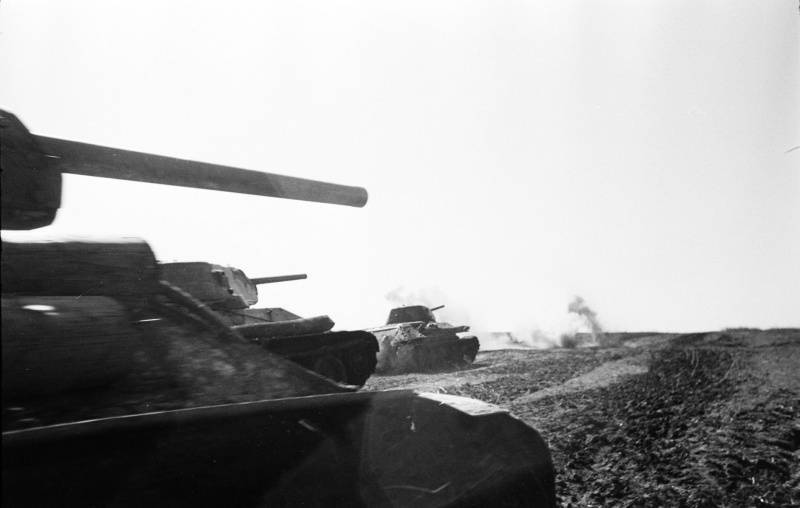
Soviet T-34-76 tanks of the South-Western Front are attacking. Photo source: http://waralbum.ru/
13 on the southern section of the breakthrough front was extended to 55 km, and the depth reached 25 – 30 km. Enemy resistance weakened. May 14 Soviet divisions created the conditions for the introduction of mobile units into the breakthrough in order to develop the success and environment of the German group in the Kharkov region. The swift and powerful strike of two tank corps (around 300 machines) could prove to be quite effective at that time. However, the command of the South-Western Front, mistakenly believing that the enemy was concentrating a large mechanized grouping in the Zmiev region, delayed the introduction of tank corps into the battle, in order to enter them into a breakthrough with the exit of rifle divisions to the Berestovaya line, which was to be fought with 15 km, which was a serious mistake. The rifle divisions had already exhausted their forces, and further progress was given to them with great effort. And the Germans used this time to stabilize their defenses and regroup their forces.
May 13 in the north The 28 Army overcame the main German defense zone and reached the approaches to Kharkov, to the line of heights surrounding the city from the east. The troops of the 38 Army Moskalenko in the first half of the day advanced another 6 km. However, problems started. The commander of the German 6 Army, General Paulus, made a regrouping of his forces: from Kharkov against the 38 Army, the 3-I and 23-I tank divisions were launched. In addition, the transfer of the 4 air fleet from the Crimea to Kharkov began. At 13 hours, the Germans, concentrating two mobile groups during the night and the first half of the day, struck from two sides at the junction of the 38 army with the 28 army. One group included the 3-I tank division and two infantry regiments, the second was the 23-I tank division and one infantry regiment. The troops of the 38 Army did not stand up and were thrown back to their original positions. Tymoshenko ordered the 28 Army to transfer the 162 Infantry Division and the 6 Guards Tank Brigade to Moskalenko.
14 May Army Moskalenko still fought with two German tank divisions, trying to keep in touch with a neighbor. Troops of the 21 Army of V.N. Gordov trampled on the spot, laying soldiers in frontal attacks on fortified points and skyscrapers. It came to the point that the commander-in-chief had to explain to General Gordov that the enemy’s resistance points should not be taken in the forehead, they must be blocked and bypassed, forcing the offensive in every way. The divisions of the 28 Army Ryabyshev advanced another 6 – 8 km and reached the rear line of the German defense, passing along the rivers Kharkov and Moore. According to the plan of operation at this time, the mobile group (3 th cavalcourse and 38 th rifle division) were to enter the breakthrough. But due to poor management organization, these compounds did not have time to focus on the starting line. The headquarters of the formations and Tymoshenko’s headquarters were at a great distance from the front line (sometimes they were separated by 20 – 30 km and more), the radio communication did not work well, and the call signs of the units were mixed up. In the south, 6-I Soviet army reached the line, no more than 35 – 40 km from the southern suburbs of Kharkov.
On May 15-16, the forces of the northern Soviet grouping mostly defended themselves. The Germans fiercely counterattacked. On May 17, General Ryabyshev, in order to restrain the onslaught of the enemy, was forced to enter into battle the main forces of the 3 Guards Cavalry Corps. As a result, the northern grouping of the Southwestern Front spent all its reserves. In the south on the evening of May 16, our troops crossed the Berestovaya and captured the bridgehead, creating the conditions for the introduction of tanks into battle. However, due to the late flood, the river has greatly spread, and the wide marshy floodplain, the viscous banks have become a serious obstacle for tanks. It was necessary to restore the bridges destroyed by the enemy, and General Gorodnyansky postponed the commissioning of tank corps until the morning of May 17. At the same time, the Bobkin group crossed the river and embraced Krasnograd from three sides.
The troops of the 6 Army recaptured the destroyed bridges on Berestovaya at night, and in the morning the commander began to bring the 21 and 23 tank corps into battle. The tanks penetrated into the German defense on 12-15 km and in the vicinity of the Vlasovka station, cut the Kharkov-Krasnodar railway. The Bobkin group continued to fight for Krasnograd, it broke away from the rear bases and began to feel a shortage of ammunition. No one else knew that the battle was already lost. Soviet troops continued to rush to Kharkov.
Thus, the shock groups of the South-Western Front during the three-day stubborn battles, not without difficulties, but broke through the defenses of the 6 of the German army north and south of Kharkov. The offensive of the left wing of the South-Western Front really put Paulus's troops in a difficult position. 14 in May, the southern shock group created the conditions for introducing mobile units into the breakthrough with the aim of developing success and surrounding the German group in the Kharkov region. The swift and powerful strike of two tank corps could prove to be quite effective at that time. However, the command of the South-Western Front, mistakenly believing that the enemy was concentrating a large mechanized grouping in the Zmiev region, delayed the introduction of tank units into the battle. The refusal to use mobile connections on the most critical days for the development of the offensive - 14-15 in May, had the most negative impact on the development of the operation. The advancing rifle divisions have exhausted their forces, the pace of the attack has declined sharply. May 17 tank corps entered into a breakthrough, but the good moment was already missed. The Germans at this time pulled reserves and entrenched on the rear lines of defense, and in the north launched a counterattack. The forces of DI Ryabyshev’s 28 Army and KS Moskalenko’s right flank of the 38 Army had to repel a counterattack by German troops on the outskirts of the railway and the Belgorod-Kharkov highway. Our troops lost the initiative.
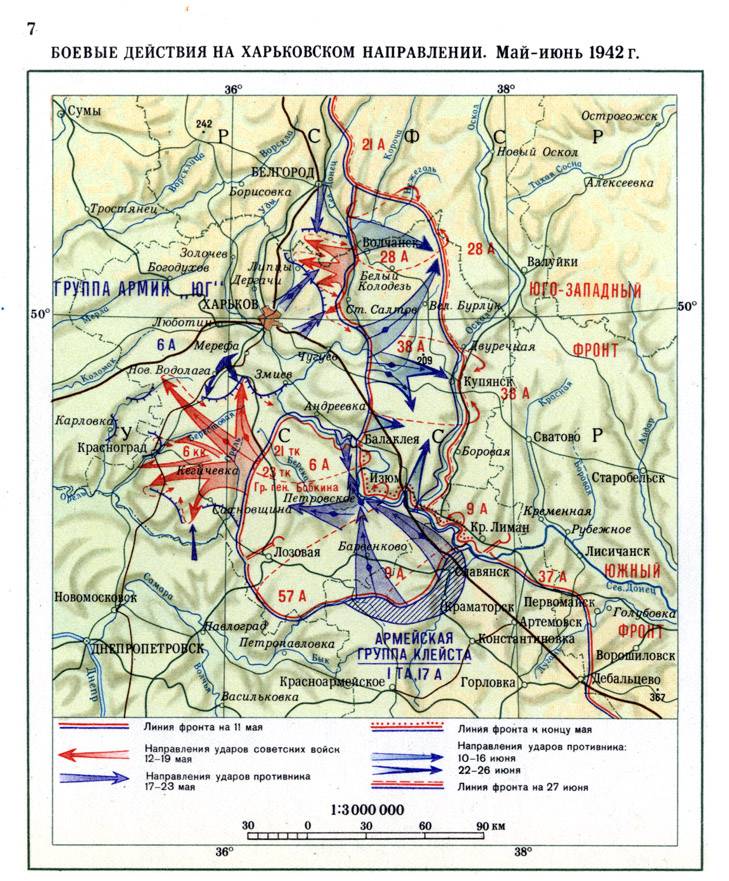
German counteroffensive
In the meantime, the German command was able to restore defensive orders and complete the regrouping of troops. The lack of active operations by Soviet troops in other sectors of the front and the return of the main forces of the 4 air fleet allowed the German command to freely transfer its reserves to the dangerous area. The German command, which was preparing a strategic offensive in this direction, quickly assessed the favorable aspects of the current situation. Halder convinced Hitler that the Kleist army group could launch a counter-strike to the Russians and thus turn a difficult defensive battle into a successful offensive operation. The Führer ordered Kleist to push his tank army to shock positions against the southern front of the Barvenkovsky ledge.
From 13 to 16 in May, large forces were deployed in the 57 th and 9 th actions of the Soviet armies, combined in this area into two army and one motorized corps. The 3 th motorized corps had 5 divisions, including the 14 th tank and 60 th motorized divisions. The main forces of this compound focused on the 20-kilometer stretch of Petrovka, Chrome Beam. The 44 Army Corps, consisting of four infantry and 16 Panzer Divisions, took up positions in the area of Bylbasovka, Sobolevka. To the west is the 52 Corps, from two infantry divisions and a penal battalion.
At the same time, Soviet intelligence missed the preparation of an enemy counter-offensive. They knew about the existence of the enemy group, but they underestimated the threat from its side. As Moskalenko noted, when planning the Kharkov operation, the Kleist army group was essentially not taken into account: “on her part, according to the command of the 57 and 9 armies, shared by front and direction headquarters, it was impossible to expect active actions in the near future, especially in the direction to the north "(KS Moskalenko. In the South-West direction). Thus, the strike of the Kleist group turned out to be completely unexpected for the 9 and 57 armies and the command of the Southern Front, although it was precisely the reflection of this strike that was the only task of the front of R. Ya. Malinovsky. The payback for this mistake was severe.
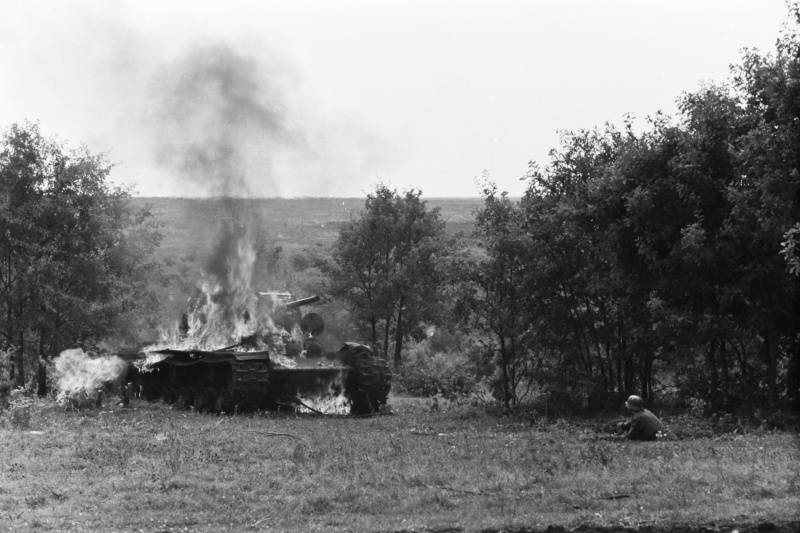
A padded and burning Soviet tank KV-1 and a Hungarian soldier sitting in a trench
On the morning of May 17, after an hour and a half of artillery preparation, the strike force of the Kleist army group (9 infantry, 2 tank and 1 motorized divisions) launched an offensive from the Slavyansk-Kramatorsk area. The Germans attacked the 9 Army of the Southern Front. At the same time, the Germans forged the troops of the Soviet 57 Army. The troops of the 9 and 57 armies could not repel the enemy attack. Already by 8 hours of the morning, the Soviet defense was broken through to the depth of 6-8 km. German ground forces supported the large forces of the 4 air fleet. German aviation struck the headquarters of the 9 Army, and the command and control was disrupted. The communication of the front headquarters with the 57 army was broken. The troops were forced to fight independently, without interaction between themselves and with the reserves of the army and the front.
It is worth noting that the Soviet defense was shallow, was built on the system of strong points and resistance nodes. In spite of the one-and-a-half-month tenure in the defense, work on the creation of defensive structures and engineering barriers was not satisfactory (another shortcoming of the Soviet command). On the entire 170-kilometer front of the defense of the 9 and 57 armies, the entire 11 km of wire barriers were installed, anti-tank barriers were not created at all. The total depth of the defensive line did not exceed 3 – 4 km. No intermediate and rear lines existed. The possibility of an enemy offensive against the Barvenkovsky bridgehead was not considered in the near future, which most negatively affected the defense of the 9 and 57 armies. Four divisions of the first echelon of the 9 Army defended on a plot of 105 km, with an average of 4-9 guns and mortars and 3 bunker for one kilometer of the front. There was no second echelon in the 9 army, as well as the 57 army. Air defense systems were small.
In addition, the troops of the 9 Army F. F. Kharitonov were greatly weakened by the previous private offensive operation. On the initiative of General Kharitonov, approved by the front commander, his troops 7-15 attacked the enemy in May to seize a strong fortified resistance center in the Mayakov area. At the same time, significant forces were gradually involved in the operation, including almost all the army reserves and the 5 th cavalcourse (front reserve), that is, the very reserves that the plan was intended to eliminate a possible breakthrough of the German troops in the Barvenkovo direction. Tymoshenko and Khrushchev knew about this operation, but did not consider it necessary to limit the initiative of Malinovsky and Kharitonov. As a result, the operation in the area of Mayakov failed, the Soviet troops suffered heavy losses. The strength of the divisions was reduced to 5 – 7 thousand people, and by the time they went on the offensive of the Kleist group they did not have time to recover.
As a result, on the very first day, German troops broke the defensive orders of the 9 Army. By the 17 clock, the Germans took Barvenkovo, in the evening - advanced on 20-25 km. By the end of May 18, the Germans, having advanced to the north by 40-50 km, reached Seversky Donets in the Petrovskoye area (30 km south-west of Izyum). German troops broke through to the rear of the 57 and 6 armies. An attempt by the Southwestern command to rectify the situation with the counter-attack of the 5 th corps and other parts of the reserve was not successful. The defeated troops of the 9 Army retreated to the north, north-west and beyond the Seversky Donets. The advancement of the German strike group created a threat to the encirclement of the entire Barvenkovo grouping of Soviet troops. In addition, the command of the South-Western direction and the front (Tymoshenko, Khrushchev and Baghramyan) underestimated the enemy and did not take the necessary measures in time to prevent the impending catastrophe. A number of mistakes were made in the leadership of the troops. The measures to eliminate the breakthrough of the enemy troops were insufficient, and then the withdrawal of armies that were under the threat of encirclement was unreasonably delayed.
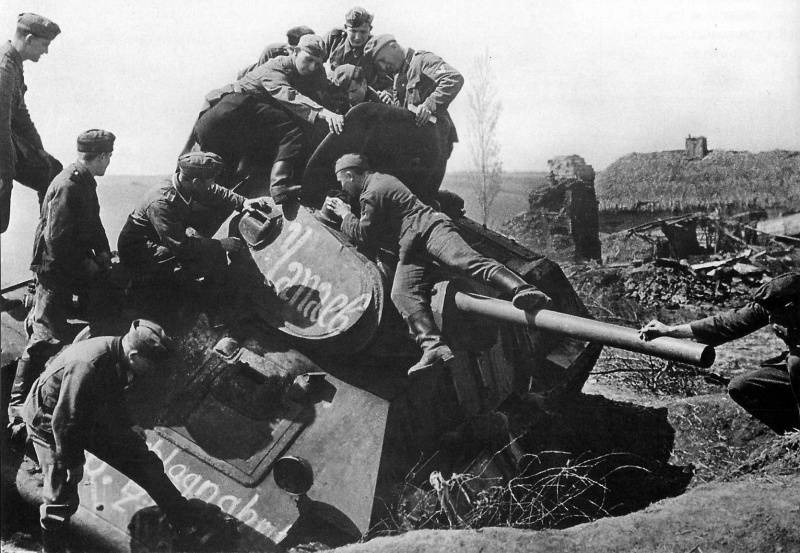
German soldiers inspect the Soviet T-34 tank with its own name "Chapaev"
In this case, the command of the South-Western direction misled and the Headquarters. Later Khrushchev tried to blame all the blame for the catastrophe on the Supreme Commander I. Stalin. They say that the Military Council of the South-Western direction proposed stopping the further attack on Kharkov, regrouping the troops and creating a strong group to repel the enemy’s counterattack. But the Stavka did not approve this decision and demanded to continue the attack on Kharkov, and the 9 and 57 armies and reserves of the Southern Front repelled the enemy strike. Khrushchev allegedly appealed directly to the Supreme with a proposal to immediately stop the attack on Kharkov and concentrate all the forces of the South-Western Front to repel the blow of the Kleist group. However, Stavka insisted on continuing the offensive.
In reality, everything was different. Tymoshenko, according to Marshal G. K. Zhukov, did not report that a real threat was created surrounding his armies. And in general, “The Military Council of the South-West direction did not show much concern ...”. A. M. Vasilevsky, who at that time served as Chief of the General Staff (due to B. Shaposhnikov's illness), in the evening on May 17 reported to Stalin about the current critical situation on the Southern Front and proposed to stop the offensive of the South-Western Front. his strike force to throw at the interception of the German threat from Kramatorsk. “The Supreme Commander,” writes Marshal A. M. Vasilevsky, “decided to speak with the commander-in-chief of the South-Western direction, Marshal Tymoshenko. The exact content of I. I. Stalin’s telephone conversations with S. K. Timoshenko is unknown to me. Only some time later they called me to the Headquarters, where I again stated my fears for the Southern Front and repeated the proposal to stop the offensive. In response, it was stated to me that the measures taken by the command of direction were quite enough to repel the blow of the enemy against the Southern Front, and therefore the South-Western Front would continue the offensive ... "(A.M. Vasilevsky. The Matter of Life). Thus, the command of the South-Western direction convinced the Supreme that the situation was under control and the attack on Kharkov was continued.
The stake allocated several divisions and tank brigades to help Tymoshenko, but they could arrive in the combat area no earlier than May 20-21. Tymoshenko subordinated the 2 Cavalry Corps of Colonel G. A. Kovalev to the Southern Front and ordered General Malinovsky with two cavalry corps, two rifle divisions and three tank brigades of the 57 and 9 armies to counter attack the broken enemy and restore the situation. At the same time, the 343-Infantry Division and the 92 heavy tank battalion were assigned from the reserve of the Commander-in-Chief to take up defensive positions on the southern approaches to Izyum. The remaining troops of the South-Western Front were ordered to continue the attack on Kharkov.
However, the situation continued to deteriorate. Tymoshenko’s order to deliver a counterblow was impossible for the troops of the Southern Front. General Pliev's 5 Cavalry Corps was already fully involved in defensive battles and was unable to concentrate forces in one direction. The Kovalev Kavkorpus was rejected by the 60 Motorized Division, General Kharitonov’s headquarters completely lost control of its troops, and the headquarters of the Southern Front did not have contact with Kharitonov or the cavalry corps. The Germans stepped up their attack on the Barvenkovo direction and, breaking the resistance of the 5 th corps, captured the southern part of Izyum. Kleist's troops began to move west along the right bank of the Seversky Donets.
In Moscow, Vasilevsky again proposed stopping the Kharkov operation and turning the strike force of the Southwestern Front south to repel the enemy. Again, this proposal was rejected after Stalin spoke with Tymoshenko. Khrushchev and Tymoshenko believed that there was no need to distract the main forces of the Bth Army and the Bobkin group to repel the attack of Kleist.
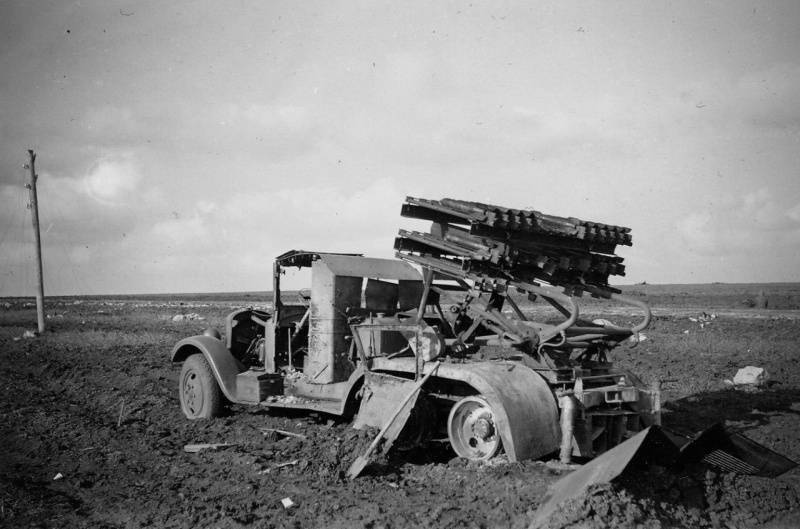
Soviet rocket launcher BM-8-36 on the truck chassis ZiS-6, destroyed at Kharkov
Barvenkovsky boiler
On May 19, the German grouping, defeating the 9 Army, created a wide 80-kilometer-long gap in the defense line of the Soviet forces and entered the main communications of the Red Army’s Barvenkovo group. Marshal Tymoshenko finally gave the order to stop the attack on Kharkov and throw the main forces of the 6 and 57 armies, the 21 and 23 tank corps to eliminate the resulting breakthrough and restore the situation on the Barvenkovsky ledge. Their offensive was to be supported by the troops of the 9 and 38 armies. But it was too late. The rapid advance of the Wehrmacht mobile units along the right bank of the Northern Donets disrupted the systematic concentration of forces of the 6 Army, the Soviet units engaged in battle separately, without the necessary artillery and aviation support. The Germans relatively easily fought off such scattered and poorly prepared attacks of the Soviet troops. The 9 Army was defeated, and the 38 Army was bound by the enemy. In addition, the Germans had superiority in the air. Therefore, it was not possible to stop the advancement of the enemy.
On May 21, exhausted and bloody the northern Soviet grouping, General Paulus redeployed the 3 and 23 tank divisions to the north front of the Barvenkov salient. The next day they forced the Seversky Donets and began to move south. On May 23, the forces of the Kleist army group were united in 10 kilometers south of Balakliya with units of the German 6, advancing from the north. 6-I and 57-I Soviet armies and army task force were in the ring environment. The leadership of the troops of the 6 and 57 armies was entrusted to the deputy commander of the Southwestern Front F. Ya. Kostenko. The surrounded troops received the task with a blow to Savintsy to break through the encirclement and reach the left bank of the Seversky Donets. Their attack had to be supported by the troops of the 38 Army, reinforced by the consolidated tank corps - fresh brigades from the Reserve Headquarters arrived.
On the night of May 24, a regrouping and concentration of troops was carried out in a hurry. But in the morning the Germans again outstripped our troops. German troops launched an offensive on a broad front, seeking to widen the punched corridor and dismember the encircled grouping into separate, isolated parts from each other. To break through the corridor to the surrounded troops failed. Simultaneously with the destruction of the encircled Soviet troops, the Germans struck northeast of Kharkov in the wolf direction in parts of the 28 army and the right wing of the 38 army. The troops of the 28 and right flank of the 38 armies returned to their original positions.
Our troops continued to fight in conditions of encirclement, with a shortage of ammunition, fuel and food, with the domination of German aircraft in the air. By May 26, the surrounded Red Army units were locked up in a small space of approximately 15 square. km in the area Barvenkovo. Only a smaller part of the surrounded troops headed by a member of the Military Council of the Front divisional commissar K. A. Gurov made its way out of the encirclement. Until the end of the month, the remnants of the Soviet troops tried to break through to their own.
Thus, the successfully started Kharkov operation ended in a catastrophe for almost three Soviet armies. Soviet losses amounted to 270 thousand people, of which 171 thousand - irrevocably, 652 tank, 1646 guns, 3278 mortars. Almost all of the command of the advancing Soviet forces died or went missing in the entourage: Lieutenant-General F. Ya. Kostenko, Deputy Commander of the South-Western Front, Lieutenant-General A. M. Gorodnyansky, Commander of the 6 Army, Commander of the 57 Army Lieutenant K.P. Podlas, Army Group Commander, Major General L.V. Bobkin, and a number of generals who commanded divisions that were surrounded.
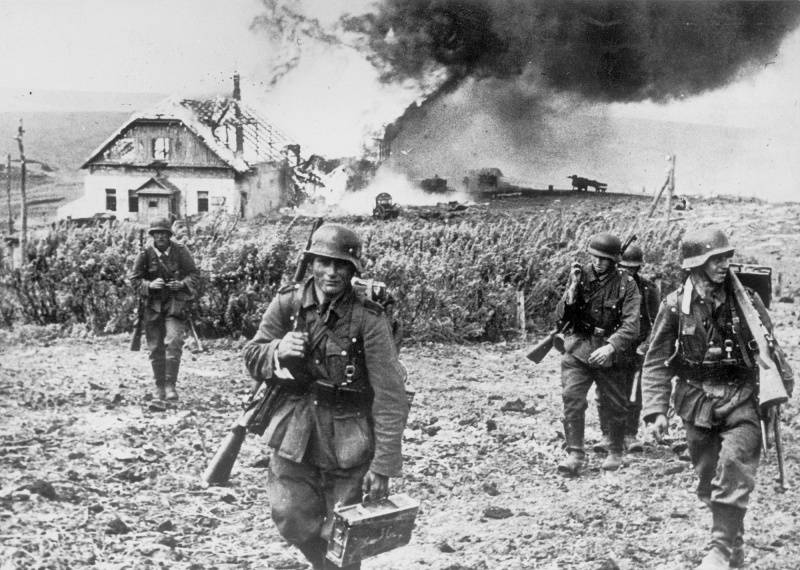
German soldiers in the Kharkov region
Results
The Kharkov offensive operation ended in a massive tragedy for the Soviet troops. Its outcome drastically changed the situation on the southern wing of the Soviet-German front in favor of the German army. The defense of the Soviet troops in the southern and southwestern fronts proved to be radically weakened. The German command is beginning to successfully develop a prearranged strategic offensive in two directions — the Caucasus and the Volga, which led to the beginning of two magnificent battles — for Stalingrad and the North Caucasus.
It should be noted that the success of the German troops in the south-western direction was due to two main prerequisites. Firstly, the German command solved the main strategic task in this direction during the 1942 campaign of the year and prepared large forces and means in this direction. The advancing Soviet army actually fell into the "trap", ran into a counter blow prepared by the German troops prepared for the offensive.
Secondly, these are the mistakes of the Southwestern command. The Soviet command poorly prepared an offensive, the Germans knew about the preparation of the Soviet troops. The intelligence, which underestimated enemy forces in the area of the offensive, did not work out clearly enough, and during the offensive itself, it was not able to promptly uncover powerful groups created by the enemy for the counterattack. As a result, the enemy’s counter-strike became unexpected. At the same time, Tymoshenko, Khrushchev and Baghramyan underestimated the enemy, believed that the Germans suffered heavy losses in this direction and were not ready for a serious offensive operation in the Barvenkovo area. Therefore, the Soviet command was preparing to attack, and the defense in the area of operation was unsatisfactory. The commander of the South-West direction did not pay the necessary attention to operational support of the offensive, especially the flanks of the attack force. The command of the Southern Front did not take measures to reliably ensure the flank and rear of the main strike force of the South-Western Front from the strike from the Slavyansk-Kramatorsk area. And when it became clear that it was necessary to withdraw the troops, Tymoshenko’s headquarters slowed down, misled the Stavka, hoped that the situation could be rectified, that victory should not be left out. In the end, it ended in disaster, the death and captivity of tens of thousands of Soviet soldiers.
Interestingly, reporting to the Supreme Commander on the results of the operation, the command of the South-West direction all the blame for the failure of the operation fell on his subordinates: “The defeat of the 9 Army largely resulted from the failure of the command of this army to control the troops in difficult conditions. Intelligence of all types of the 9 Army and the Southern Front did not timely disclose the impending strike, and thus deprived the command of the ability to take additional measures to repel the enemy's strike on the 9 Army. ... The command of the armies and part of the commanders of the corps and divisions with their headquarters turned out to be untenable to lead the troops in difficult combat conditions. As a rule, the commanding officers of armies, corps, and divisions did not lead the formations at important moments of operations and combat, but traveled around the subunits. This was the case in the group of General Kostenko and the 6 Army during the period of the semi-circle and the environment, when the army commander left for one division, a member of the Military Council to another, and the chief of staff to the third. Approximately the same order followed the command of the corps and divisions ... ".
It turned out that the command of the South-Western direction got useless commanders of armies, corps and divisions. Indeed, the commanders of the army-corps-division level made mistakes, but the main fault lies with the high command, which so conceived and organized the operation that everything ended in disaster.
And when Stalin died, and Khrushchev seized upon the leadership of the party and the USSR, he placed all the blame on the Supreme. In a famous report at the XX Party Congress, Khrushchev argued that it was Stalin who stubbornly refused to give permission to the troops of the South-Western Front to get out of attack and go on the defensive. In the 6-languidStories The Great Patriotic War of the Soviet Union ”, which was edited accordingly, also included a version of Stalin’s guilt and Khrushchev’s“ wisdom ”, who allegedly warned Bid about the threat of a German strike.
Already being retired, Khrushchev, in his Memoirs, was offended by Marshal Vasilevsky - he, it turns out, had incorrectly informed Stalin: “... certainly, I cannot bypass my conversation with Vasilevsky. He made a heavy impression on me then. I believed that the catastrophe that broke out under Barvenkovo could have been avoided if Vasilevsky had taken the position he was supposed to take. He could take a different position, but did not take it, and thus, I think, had a hand in the deaths of thousands of Red Army soldiers in the Kharkov operation ... Vasilevsky, having done wrong, did not fulfill his duty as a soldier and did not report to Stalin during Kharkov operations. "
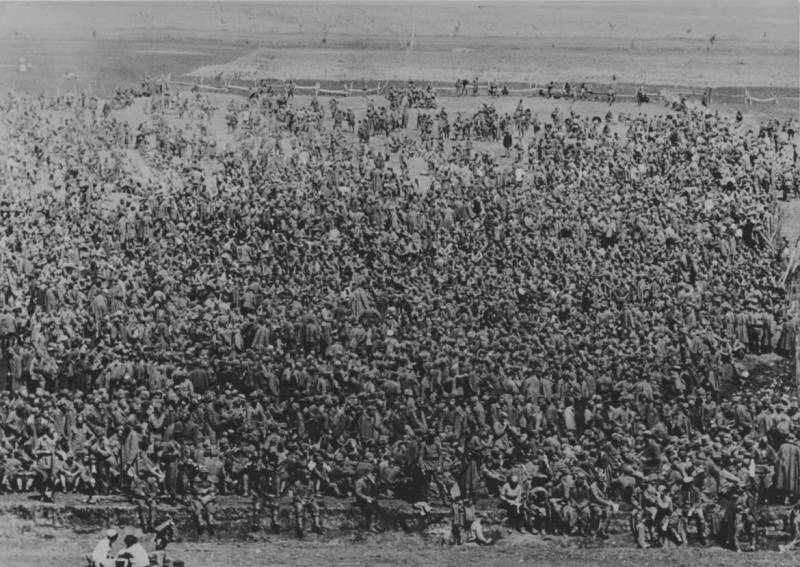
Prisoners of the Red Army at the assembly point near Kharkov
Information